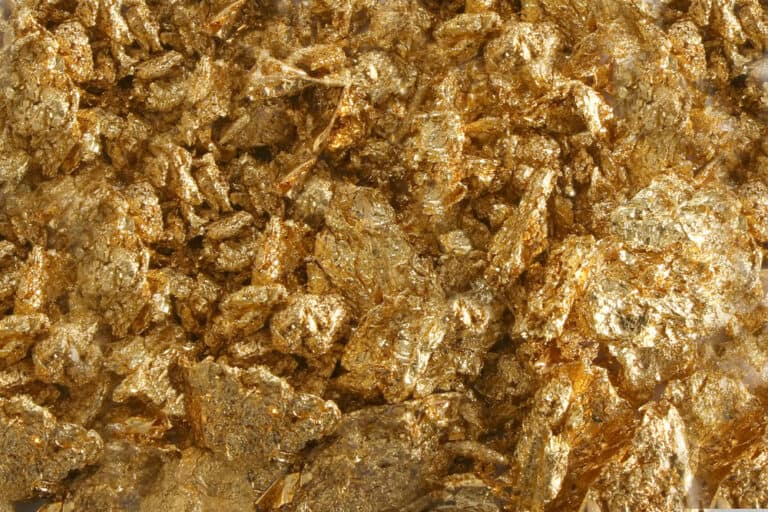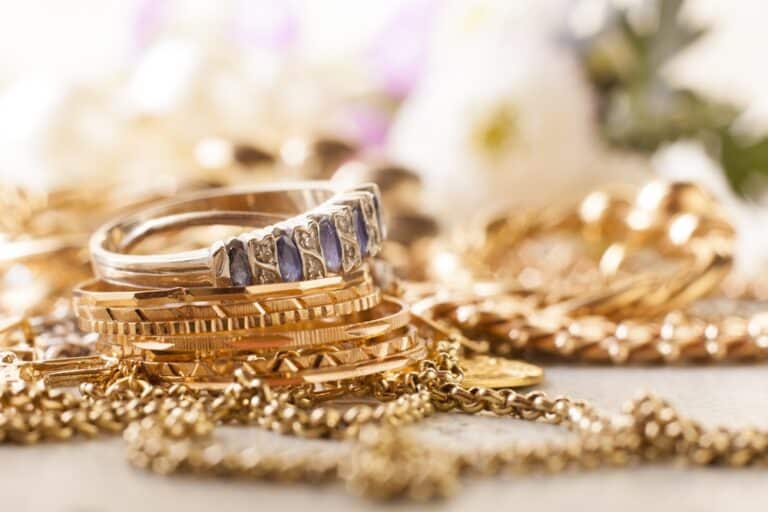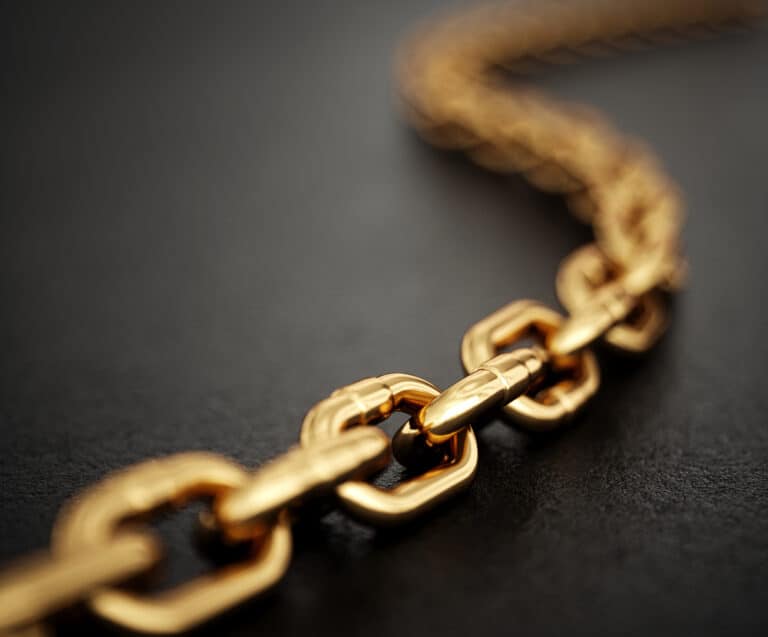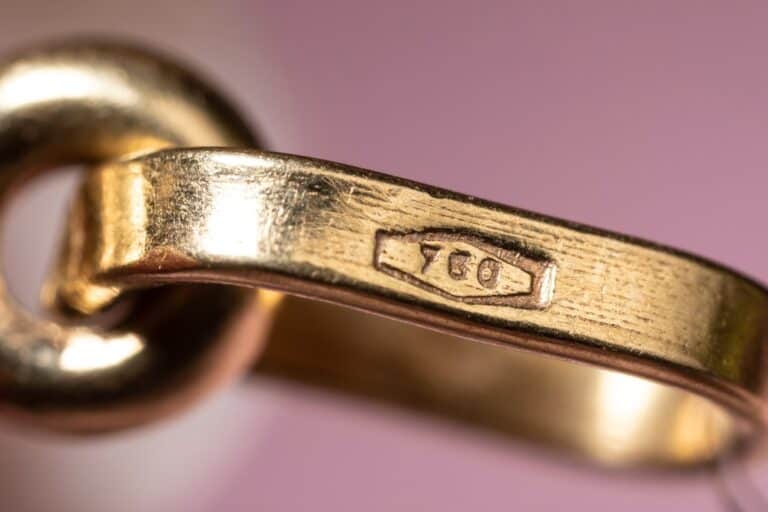If you have received a piece of gold jewelry such as a ring, you may have been examining it. If it’s an engagement ring: congratulations! We’re sure you are wondering what the marks mean. In addition to the hallmark, which indicates where it was made, you may have seen a 585. But what does 585 mean on jewelry?
585 is a stamp used on European and other international gold jewelry to indicate a purity level of 583 parts per thousand (or fineness). In other words, 58.3 percent or 14 parts of 24 are pure gold, which is equivalent to the US measurement of 14 karats.
You may well have surmised that 585 is something to do with the purity of the gold, and you would be right. However, if you are used to the karat system of determining gold’s purity, you may have trouble grasping the implications of the three-digit method and what 585 gold is. Let’s take a look.
585 Gold Is 14 Karat Gold
Although gold is pretty easy to extract in almost completely pure form, and you will find gold coins that are 99.9 percent pure, most gold jewelry is not pure gold (24 karat gold).
Pure gold is a scarce and valuable metal that does not rust or tarnish but has some disadvantages. We do not use pure gold for jewelry because it has a pronounced and, to many, unattractive orange color cast and is exceptionally soft.
Although traditional Chinese wedding jewelry such as bracelets is typically made of 24 karat gold, this is not intended for daily wear, but rather as an investment, a purpose for which this purity of gold is admirably suited. For everyday use, we need harder, more durable jewelry that will not scratch and lose attractiveness, warp out of shape, or wear through where pieces such as links rub against each other.
For these reasons, we alloy gold for jewelry with other metals to produce gold with a lower purity than 24 karat gold. The most common purity levels, or karatages, for jewelry are 10K, 14K, 18K, and occasionally 22K.
Before explaining how the three-digit system relates to karatage, we should clear up some confusion. Karat (abbreviated “K” or “Kt”) as a measure of gold purity is not the same as carat as a measure of diamond weight, although they have shared origins and, confusingly, are spelled the same way (carat) in Commonwealth countries.
How people came to measure gold in karats has to do with an early medieval German coin known as the mark. This coin weighed 24 carats (the measure of weight, which at that time was in more general use) and was gold.
However, it was not pure gold. The coins’ purity was expressed as the number of gold carats of its weight; hence, karats came to represent gold purity in twenty-fourths.
In modern Europe, a different system for measuring the purity of gold arose, known as millesimal fineness. Fineness expresses the amount of pure gold in a mixture in parts per thousand, sometimes rounded to zero or five. Gold stamped 585 or sometimes 583 is 583 parts per thousand pure, or 58.3 percent gold.
Because one twenty-fourth (one karat) is 4.1667 percent, 585 or 583 gold is 58.3 percent divided by 4.1667, or 14 karats (14 divided by 24).
So, 585 gold is 14K gold, although the millesimal system indicates purity with greater accuracy and simplifies finding the percentage of pure gold in the mixture, as the arithmetic is far more manageable.
Gold will only be stamped either with karatage or fineness. A notable difference is that the US allows gold under-karated by up to half a karat to be legally sold as that karatage. For example, jewelers may sell 13.5K gold as 14K. However, it would not receive the 585 stamp and would instead receive a 565 symbol if such a thing existed.
What Other Metals Are In 585 Gold?
585 gold (14K gold) contains 14 parts (58.3 percent) of gold and ten parts (41.7 percent) of other metals such as nickel, copper, and zinc. There are three main color options: yellow gold, white gold, and rose gold, which differ in the alloying metals jewelers have used.
585 fineness yellow gold is 58.3 percent pure gold and 41.7 percent metals such as zinc and copper. If you know something about the history of metallurgy, you’ll recognize this combination as being brass, which accounts for the vivid yellow color of this form of gold.
585 white gold is 58.3 percent pure gold and 41.7 percent alloying white metals such as nickel, silver, and palladium to produce a whitish color similar to platinum. A rhodium coating usually protects this form of gold.
585rose gold is 58.3 percent pure gold and 41.7 percent alloying metals, always including copper to produce a rosy color. Higher percentages of copper produce deeper reddish tints, whereas a proportion of other alloying metals such as silver results in more delicate pinkish hues.
The Pros And Cons Of 585 Gold
585 fineness or 14 karat gold is the most popular form of gold for jewelry such as engagement rings, as it strikes a good balance between the strengths of pure gold and those of the alloying metals. Like other karatages of gold, it has particular pros and cons, although these depend to some degree on the alloying metals.
585 fineness gold is relatively affordable while retaining a fair degree of value, durable, and has a striking appearance. However, depending on the alloying metals, it can trigger allergic skin reactions.
Advantages Of 585 Gold
Because it is only 58.3 percent pure gold, 585 (14K) gold remains pretty affordable and is a good option for a budget while retaining more resale value than 10K (417) gold. As a result, it is a better investment. Rose gold, in particular, is not too expensive but sought after.
The alloying metals in 585 gold make it durable, and it will not easily scratch, scuff, or get dented or warped out of shape, making it suitable for jewelry for wearing daily. Rose gold is an especially tough alloy due to copper’s strength.
Whether you choose traditional yellow gold, fashionable white gold, or charming rose gold, 585 gold has a striking depth of color that makes it eye-catching and beautiful. This form of gold is a good option if you are looking for visual appeal.
Disadvantages Of 585 Gold
In general, 585 fineness (14K) gold is well-balanced and has few real disadvantages. However, it does have a relatively high proportion of alloying metals that can cause allergic skin conditions with prolonged wear (contact dermatitis).
This issue is particularly pronounced with white gold that has been alloyed with nickel – if you are allergic to this metal, seek out hypoallergenic white gold that has been alloyed without this metal in the mixture. Yellow gold is far less likely to cause contact dermatitis due to the metals used to make it.
White gold also requires dipping every few years to renew its rhodium coating. Many jewelers offer this as a free service; however, it is an additional hassle.

Conclusion
We hope you are thrilled with it if you have received a beautiful piece of gold jewelry. Now you know that stamp 585 indicates 14 karat gold, and your eye should tell you what color the gold is, meaning you can guess what metals the manufacturing jeweler has used as alloys.
References
- https://www.gold.org/about-gold/about-gold-jewellery
- https://www.britannica.com/technology/karat
- https://www.diamonds.pro/education/10k-14k-18k-24k-gold-compared/
- https://www.diamonds.pro/education/14k-gold/
- https://bellatory.com/fashion-accessories/750-585-417-gold-markings-jewelry
- https://www.quora.com/What-does-585-mean-on-jewelry






